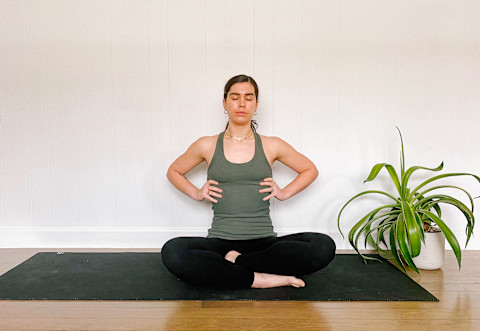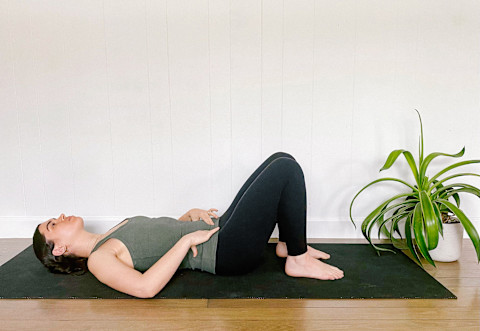4 Diastasis Recti Exercises To Try + What To Avoid, According To Experts

New moms already have a lot to deal with when it comes to the wild journey the human body goes through during pregnancy. As a certified prenatal and postpartum corrective exercise specialist, I can't stress enough how important it is for moms to take care of their own bodies, too.
One of the most common issues to come up during pregnancy is diastasis recti abdominis, or DRA for short.
What is diastasis recti?
According to Michele McGurk, P.T., WCS, PRPC, an APTA board-certified women's health clinical specialist in physical therapy, diastasis recti is "a separation of the right and left rectus abdominus muscles, the muscles that give you a 'six-pack.' Research indicates all pregnant women have a DRA by 35 weeks' gestation1, and a separation persists in 35 to 39% of women at six months postpartum."
Healing your diastasis recti can take some time, but McGurk says most women will make a full recovery within a year of delivery. Exercise is one of the most efficient ways to support this healing—but exercising incorrectly can delay the process. For example, "doing crunches without reeducating and strengthening the deeper muscles will worsen a DR," says McGurk. "This is something that should be monitored by a therapist or trainer before attempting."
The best exercises for diastasis recti.
Before returning to your go-to fitness routine, it's crucial to train the deepest core muscles, the transversus abdominus (or transverse abdominal muscle), to co-contract with the pelvic floor so that the diastasis recti can heal. McGurk explains, "There tends to be an overactivation of the oblique abdominal muscles" in these cases. The exercises below can help you find a deeper contraction in those core muscles, which reeducates the muscles to work together:
Seated 3D Breathing

- Find a comfortable seated position.
- Inhale, allowing the sides and backs of the ribs to widen while releasing the pelvic floor (the muscles you contract to stop yourself from going to the bathroom).
- Note: If you're struggling with incontinence from pregnancy, practicing this in the shower in the beginning can be helpful.
"Starting at a rehabilitative stage is important," says McGurk, "and learning to isolate transversus abdominis coordinated with the breath is key."
Supine Transversus Abdominis Check

- Lie on your back and place your fingertips inside the pelvic bones. (Pro tip: Come to the floor by coming to your side, using your upper body, and then rolling onto your back to avoid a crunch action. Roll to your side and use your upper body to get back up, too!)
- To find your deepest abs, as you exhale, draw the deep abdominals toward center as if you were lacing a corset—without sucking in.
"If you feel muscle popping into your finger pads when engaging, you are likely engaging the oblique muscles," says McGurk. "Try with 50% less effort or try a different verbal cue. What you should feel is a deeper, more subtle gliding of muscle; this is the transverse abdominis." An alternative cue here could also be gently hugging the stomach away from the waistband, without squeezing.
Neutral Spine Toe Taps
- Lie on your back with your knees bent and feet flat on the floor in neutral spine.
- As you exhale, float the right leg up to a tabletop position while hugging the abdominals in and engaging the pelvic floor.
- As you inhale, return the foot to the floor and release the core and pelvic floor. Alternate and repeat 10 times.
- When you feel ready, as in you can isolate your transverse abdominis from the previous exercise, you can start with your legs in tabletop to make it more intense.
Keeping the knees bent at 90 degrees is important to avoid putting too much load on the abdominals before they are ready—so pace yourself and really tune in to your body before trying any straight-leg abdominal exercise variations.
Neutral Bird Dog
- Start on all fours, in neutral spine.
- Exhale to hug the stomach in, and inhale to fully and completely release the core.
- When you're ready, you can add opposite arm and leg reaches to challenge core stability and intensify the exercise further.
Your eyes aren't fooling you; this is the same exercise as 3D breathing—but setting up on all fours allows you to work against gravity to make it a little tougher.
Exercises to avoid with diastasis recti.
To heal diastasis recti, you want to engage the deep core muscles and let the rectus, or "six-pack" muscles rest. You should avoid any exercise that puts pressure on the compromised rectus abdominis until you've addressed the separation, or it could get worse.
What's more, "returning to exercise 'as usual' could worsen or contribute to pelvic floor dysfunctions or lower back pain," says McGurk. This includes traditional fitness moves that involve flexion of the spine like the Pilates 100s, roll-ups, and crunches; or anything that further stretches the separation like yoga backbends, cobra, camel, and wheel. You should also avoid exercises like box jumps or planks that can stress the rectus muscles.
When in doubt, keep your spine in neutral and do your transverse abdominis isolation exercise to check which muscles you're using. Everybody will respond differently to pregnancy, but it's good to keep in mind that even if you're feeling "up for" an exercise or movement, it may not be in your best interest until the diastasis recti are closed.
Other forms of treatment.
In addition to therapeutic exercise, manual therapy can make a huge difference in your healing timeline and help manage common postpartum pain like lower back, hip, and pelvic pain.
McGurk is a staunch believer that every single woman should see a pelvic physical therapist, ideally at six weeks postpartum. "This type of treatment will facilitate their own healing process; address common postpartum symptoms like pelvic pain and urinary leakage; as well as prevent issues in the future."
Of course, not everyone has an opportunity to see a PT right away, but McGurk recommends seeking help if you're still dealing with a separation of two fingers width or more at six months postpartum.
Bottom line.
Diastasis recti abdominis can be a pain, but it is definitely treatable. Avoid any type of exercises that put a strain on your rectus abdominis, and prioritize moves that activate the transverse abdominis. Be sure to seek help from a doctor or physical therapist before making any changes to your postpartum routine.

